Francisco Goya’s The Third of May 1808 (fig. A) depicts the gruesome aftermath of a Madrilenian uprising against the Grande Armée who, under the leadership of Napoleon Bonaparte, had invaded their country two months prior. Words like “raw” and “visceral” often surface in discussions of this painting, and it’s easy to see why, for it has an extremely rudimentary quality. From the partially unfinished background that seems to suspend the scene outside of space and time, to the simplistic composition which contrasts the nameless killers against the expressive faces of their victims, The Third of May delivers is message clearly and succinctly: Spain—good, France—bad.
Goya has often been referred to as a ‘quintessential’ Spanish artist, and it is patriotic scenes like this which helped him earn that reputation. But sometimes the greatest works of art can also be the most deceptive. Who, for instance, could look at a painting like The Third of May and figure that it was created not from Goya’s own volition, but commissioned by a king who, upon returning from exile after Napoleon’s defeat, sought to solidify his rule through nationalist propaganda? Only when comparing the work to its lesser known younger brother, The Second of May 1808 (fig. B), and noting the similarities between the prisoner pleading for his life in one, and the soldier stabbing the chest of a French mercenary in the other, do we discover a trace of Goya’s true voice, and it hates the Spanish monarchy with a burning passion.
Goya’s distaste for his Bourbon kings can be traced back to some of the very first paintings he produced for them, like, for instance, Carlos III in Hunting Costume (fig. C). At first glance a rather straightforward royal portrait that champions themes of simplicity and sobriety, it quickly and inevitably draws attention to the king’s awkward posture, his feebly-bent back and submissively-lowered head. Together with the bayonet resting idly in his hands, as well as the white hunting dog curled up beside him, the picture suggests ideas of meekness and inertia—two qualities no self-respecting head of state wants to be associated with. Although it is unknown whether Goya had intended to ridicule Carlos—a monarch who, unlike his successors, was accepting of the French Enlightenment—the belittling brushwork speaks for itself, especially when placed next to another portrait by Anton Raphael Mengs (fig. D), which depicts the same person—here erect and dressed in gallant armor—as a much stronger and more capable ruler.
The literature on Carlos III is regrettably slim, but only because the work is overshadowed by the portrait of the semi-enlightened king’s conservative son, Carlos IV, whose family Goya immortalized some twelve years later (fig. E). Neither pious nor cowardly enough to refrain from taking a jab or two at the same people who provided him with status and—more importantly—income, Goya’s ambiguous depiction of the royal households has puzzled critics for centuries on end. Art critic Helen Gardner, in one extreme example, referred to the subjects as “a menagerie of human grotesques.” While that may be a bit too harsh, it’s certainly difficult to ignore the discomforting impression this work makes. From the portly, constipated king brushed off to the side, to his bony wife who domineeringly occupies the center of the frame, to their band of children looking smug, confused, and afraid, these cannot possibly be the stewards of a country on the rise.
Given that the majority of family members, king and queen included, as a matter of fact personally approved Goya’s sketches beforehand—at times even congratulating him on having achieved their likeness—one is inclined to dismiss any and all claims of ridicule. However even if the Bourbons, unlike Napoleon, whose own portraits humble those of Louis XIV, were mature enough to accept their own imperfections, that does not mean Goya was able to do the same. When placed side by side another famous portrayal of a royal family, Diego Velazquez’s 1656 Las Meninas (fig. F), Goya’s artistry betrays hints of criticism that go far beyond mere caricature. Given that Velazquez was one of his biggest inspirations, it makes sense that Goya would pay homage to the legendary painter’s composition, but the ways in which he did raise questions. First, both painters included themselves in the picture, each on the far left of the side of the frame. However, whereas Velazquez comes across as a family friend whose employers evidently enjoy his company—and vice versa—Goya stands separated from the scene, enveloped in shadow, looking on as though his clients do not want him there, or worse: do not even know he’s there.
Second is the painting’s centerpiece, which in Velazquez’s is the adorable young princess, Margaret Theresa, but in Goya’s has been replaced by the haggardly and hard-eyed Queen Maria Luisa of Parma, who commands a degree of attention that she (we feel almost instinctually) should not receive. Those who doubt the merit of this comparison should note the near-identical pose little girl and old woman share between them: foot forward, body turned to the right with faces following suit. At this moment, it should be noted that Goya’s queen was known as an incorrigible woman who shamelessly exploited her husband’s soft heart and spineless body. Openly and actively engaged in a long-running affair with some warmongering secretary—an affair which, not unimportant to Goya, posterity has held responsible for ending the career of Spain’s most progressive minister, Count Floridablanca. Knowing this, the third and final link between the two paintings—Velazquez’s servile handmaiden and Goya’s cuckold king of Spain—need no further explanation.
Worst of all, however, was the Prince of Austurias, that self-satisfied young lad in blue standing on the left side of Goya’s picture who, positioned closer to the foreground than any of his family members, including the king himself, casts an ominous shadow onto the otherwise brightly-lit floor. The Prince was later to become known as King Fernando VII—the same king who would commission The Third of May. His own wife, whom Goya has cunningly depicted facing away from her future husband in the portrait, once described him as,
…idle, deceitful, mean, sly, and not even a man physically. It is a shame when at the age of eighteen one responds to nothing: neither commands nor persuasion have any effect on him…The Prince does nothing, doesn’t read, doesn’t write, doesn’t think…nothing…and this is deliberate because they want him to be an idiot (Bonafoux).
Regardless of who was responsible for his incompetence, Fernando dealt greater damage to Goya’s personal beliefs than any Spanish monarch the painter ever had the displeasure of serving. Though his crimes against the Age of Enlightenment are manifold, the most severe among them have to do with the Constitution of 1812, which Goya commemorated in his Truth, Time and History. Drafted by the Supreme Junta, a makeshift government organization which replaced the dismantled House of Bourbon during the Peninsular War, this piece of text was Spain’s equivalent of the French Declaration of the Rights of Man and the Citizen in that it promised to turn Spain from an absolute into a constitutional monarchy, abolish the Inquisition, provide freedom of speech as well as universal male suffrage, and create a unicameral legislative branch of government. Guerillas, artisans, pueblos and ilustrados alike, all shared in their enthusiasm for this legal document—all except Fernando, who wrote it off as a parasitic leftover of Napoleonic influence, and vowed never to accept it.
Ironically, Goya’s eccentric imagination, documented most clearly in his feared Pinturas Negras, was not much crazier than the reality in which he found himself. By the time he went into retirement, he had witnessed a series of events that were surreal to say the least. Fernando, who had less than a decade ago fled the country to escape Napoleon, was now being offered protection by the same soldiers that once sought to destroy him. When the French army successfully put a stop the Liberal Revolt, a last attempt of Spanish patriots to implement their revolutionary constitution, the king ordered its leader, the guerilla commander Riego y Nuñez, to be dragged to a public execution by a couple of donkeys whilst tied to a large bag of coal. Meanwhile, the contented lord replaced the army officers who had failed him with people who were as if not slightly more inept than their predecessors. The newly instated captain-general of Cataluña Carlos d’Espagnac, for example, was as erratic and unreasonable as the ruler who had appointed him, and a demented despot known to dress up in gala uniform and give live dance performances when there were liberals to hang. And Goya? Goya took refuge where he always had: in his art.
–Tim Brinkhof
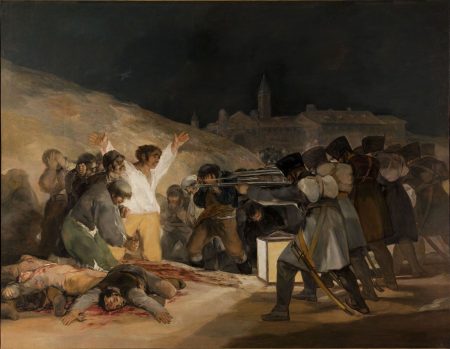
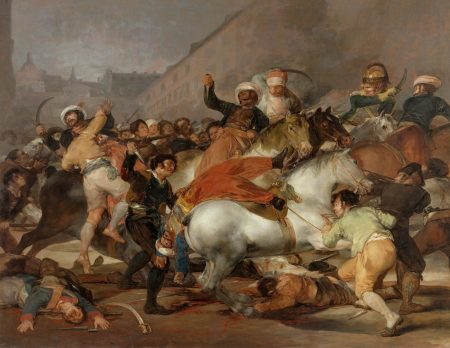
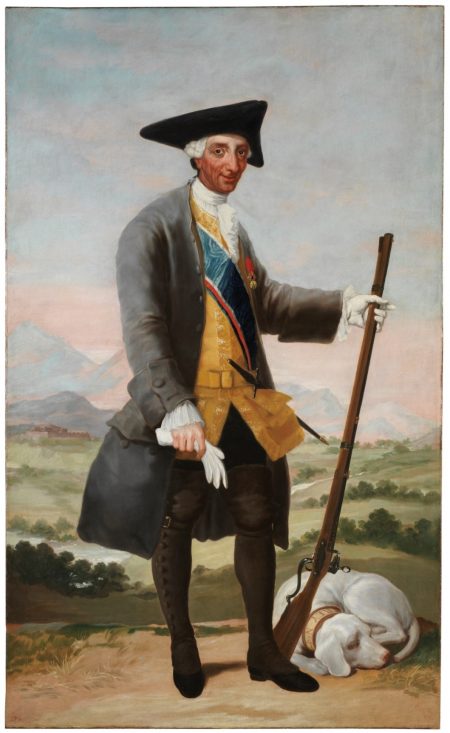
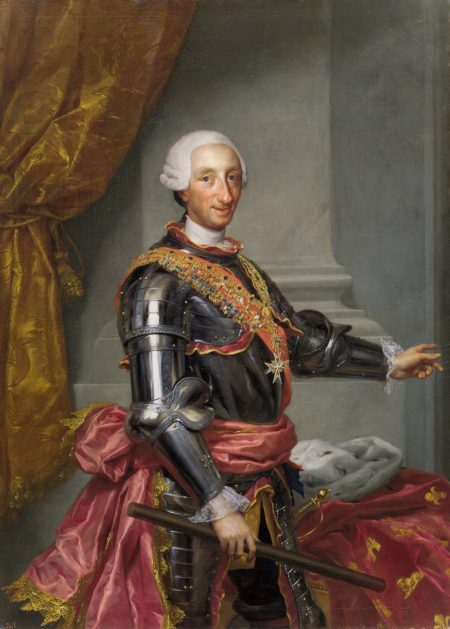
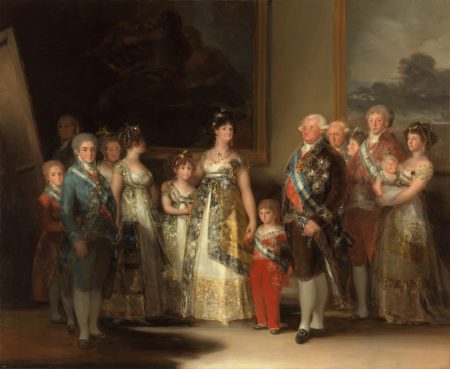
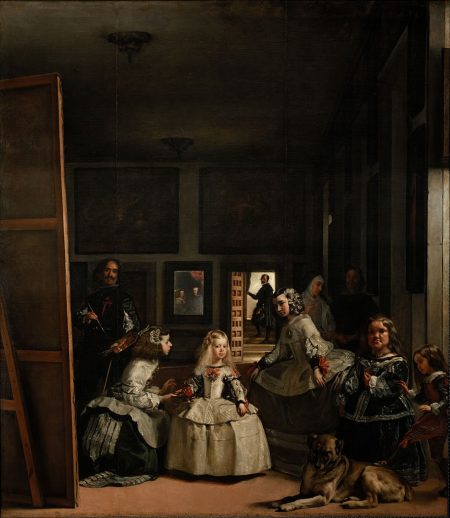
Bibliography
Bonafoux, Pascal. Portraits of the Artist. New York: Rizzoli International Publications, 1985.
De la Croix, Horst and Richard Tansey. Helen Gardner’s Art Through the Ages. San Diego: Harcourt, Brace & World, 1970.
Fraser, Ronald. Napoleon’s Cursed War: Spanish Popular Resistance in the Peninsular War. New York: Verso, 2008.
Goya y Lucientes, Francisco Javier. Colección de cuatrocientos cuarenta.
Hughes, Robert. Goya. New York: Knopf, 2006.
Licht, Fred. Goya: The Origins of the Modern Temper in Art. London: Palgrave McMillan, 1979.
Muller, Priscilla. Goya’s Black Paintings: Truth and Reason in Light and Liberty. New York: Hispanic Society of Amer, 1984.
Nerdwriter1. “The Most Disturbing Painting.” YouTube, commentary by Evan Puschack, 1 Mar. 2019, https://www.youtube.com/watch?v=g15-lvmIrcg.